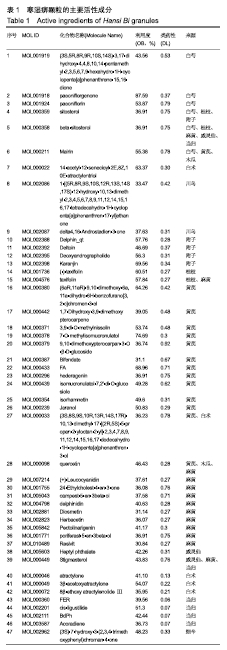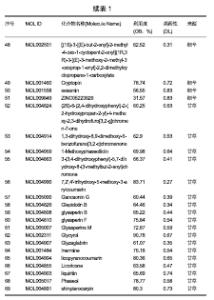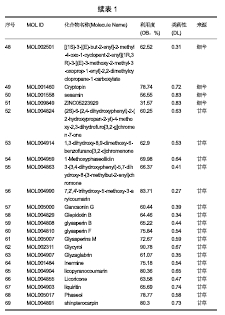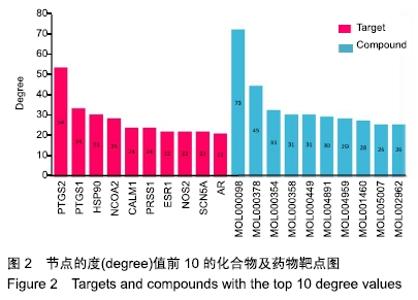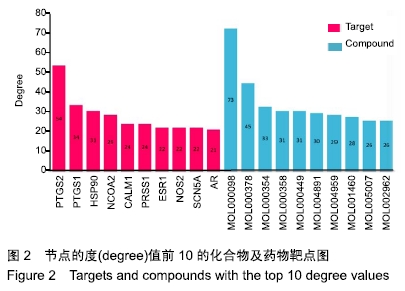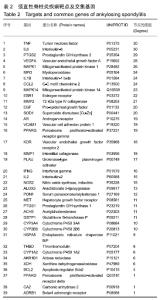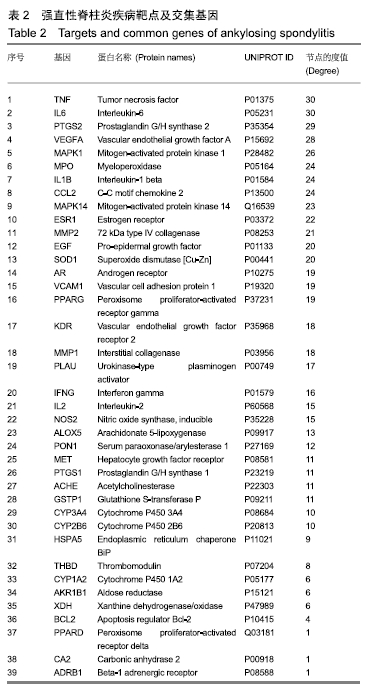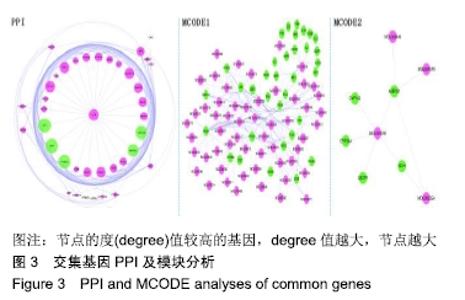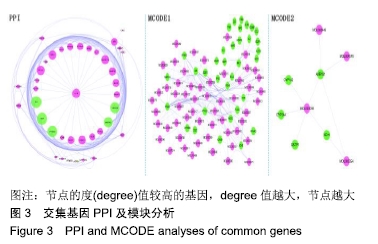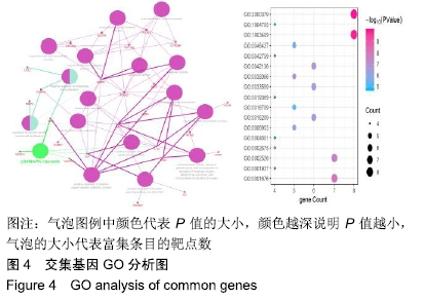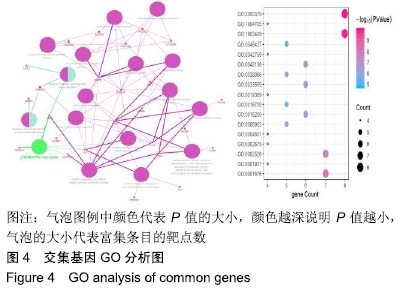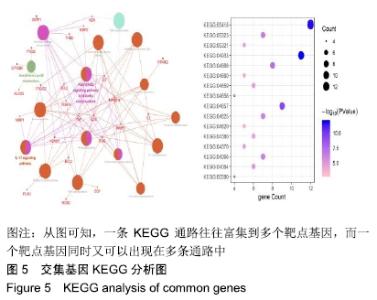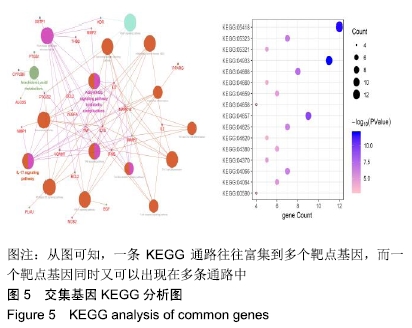Chinese Journal of Tissue Engineering Research ›› 2020, Vol. 24 ›› Issue (11): 1738-1744.doi: 10.3969/j.issn.2095-4344.2437
Previous Articles Next Articles
Mechanism of Hanshi Bi granules in the treatment of ankylosing spondylitis based on network pharmacology
Wang Zhuo1, Shi Zhongfeng2, Wang Fengyun1, Li Weidong3, 4, Han Liang3, 4
- 1School of Traditional Chinese Medicine, 2New Drug Research and Development Center, 3School of Health, Guangdong Pharmaceutical University, Guangzhou 510006, Guangdong Province, China; 4Guangdong Light and Health Engineering Technology Research Center, Guangzhou 510310, Guangdong Province, China
-
Received:2019-05-13Revised:2019-05-25Accepted:2019-07-27Online:2020-04-18Published:2020-02-29 -
Contact:Han Liang, MD, Master’s supervisor, School of Health, Guangdong Pharmaceutical University, Guangzhou 510006, Guangdong Province, China; Guangdong Light and Health Engineering Technology Research Center, Guangzhou 510310, Guangdong Province, China -
About author:Wang Zhuo, Master candidate, School of Traditional Chinese Medicine, Guangdong Pharmaceutical University, Guangzhou 510006, Guangdong Province, China -
Supported by:the National Natural Science Foundation of China, No. 81703816
CLC Number:
Cite this article
Wang Zhuo, Shi Zhongfeng, Wang Fengyun, Li Weidong, Han Liang. Mechanism of Hanshi Bi granules in the treatment of ankylosing spondylitis based on network pharmacology[J]. Chinese Journal of Tissue Engineering Research, 2020, 24(11): 1738-1744.
share this article
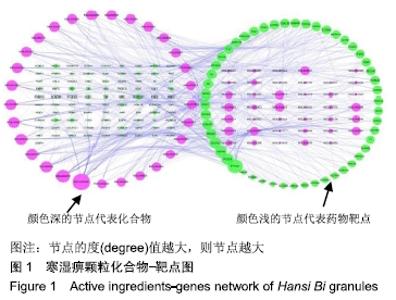
2.2 寒湿痹颗粒化合物-药物靶点网络图分析 寒湿痹颗粒中所含有69个化合物对应靶点基因142个,使用Cytoscape3.6.1构建化合物-药物靶点网络并分析。通过使用Cytoscape3.6.1中Network Analyzer工具对进行网络拓扑结构分析,使用节点的度值(degree)的大小来判断节点在整个网络中的重要程度,见图1。通过软件分析可知,网络有211个节点,911条边组成,将degree值前10的化合物及药物靶点绘制成柱状图,如图2,其中化合物排名前五位的分别是:MOL000098(槲皮素,quercetin)的degree值为(73个靶点),其节点最大,MOL000378 (7-O-甲基异丙醇胺,7-O-methyliso-mucronulatol)的degree值为45,MOL000354 (异鼠李素,isorhamnetin)的degree值为33,MOL000358 (β-谷甾醇,beta-sitosterol)的degree值为31,MOL000449(豆甾醇,Stigmasterol)的degree值为31;其药物靶点基因排名前五位分别是:前列腺素G/H合成酶2 (prostaglandin G/H synthase2,PTGS2)的degree值为51,前列腺素G/H合成酶1(prostaglandin G/H synthase1,PTGS1)的degree值为34,热休克蛋白(heat shock protein HSP90,HSP90)的degree值为31,核受体辅激活蛋白2 (nuclear receptor coactivator 2, NCOA2)的degree值为28,钙调蛋白1基因(Calmodulin-1, CALM1)的degree值为24,从化合物与靶点之间的关系可知,一个化合物往往与多个靶点相对应,而一个靶点同时也与多个化合物存在相互作用关系,这说明寒湿痹颗粒是通过多成分、多靶点、多途径协同来起效的。 "
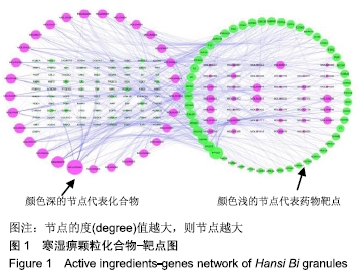
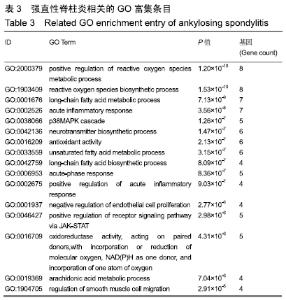
2.5 交集基因GO富集分析 交集基因利用ClueGO插件,富集条件为P ≤ 0.05,Cluster#1=4,Kappa Score等于0.4,其余条件为默认设置,获得与强直性脊柱炎相关的项目有16条,主要包括:活性氧代谢过程的调节(positive regulation of reactive oxygen species metabolic process)、活性氧的生物合成过程(reactive oxygen species biosynthetic process)、长链脂肪酸的代谢(long-chain fatty acid metabolic process)、急性炎症反应(acute inflammatory response)、神经递质生物过程(neurotransmitter biosynthetic process)、花生四烯酸的代谢过程(arachidonic acid metabolic process)、经JAK-STAT对受体信号传导途径的调节(positive regulation of receptor signaling pathway via JAK-STAT)等,见表3。使用CluePedia插件将GO富集条目与靶点绘制生物学功能网络图,同时根据每条项目的P值及基因数的不同绘制成气泡图,见图4。从生物学功能网状图可知,肿瘤坏死因子、前列腺素内过氧化物合酶2、前列腺素内过氧化物合酶1、白细胞介素6等交集基因与作用于多种生物学功能,而一种生物学功能与多个交集基因存在相互作用联系,这提示寒湿痹颗粒治疗强直性脊柱炎可能是通过多靶点多种生物学功能整体调节。 "
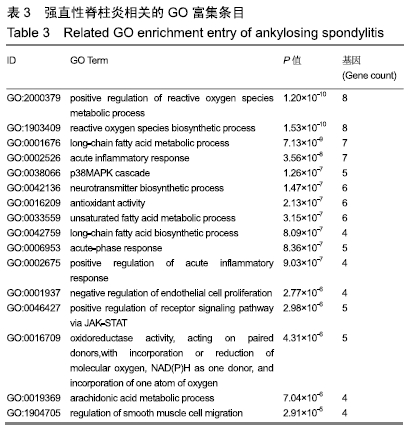
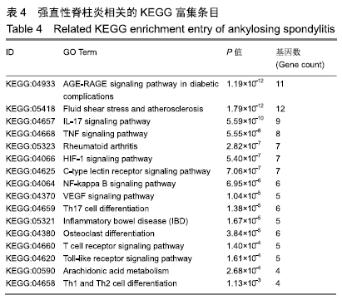
2.6 交集基因KEGG通路富集分析 为了进一步阐述其作用通路,使用ClueGO插件进行KEGG通路分析,通路富集条件为P ≤ 0.05,Cluster#1=4,Kappa Score=0.4,其余条件为默认设置,其中与强直性脊柱炎直接相关的通路有16条,主要包括:AGE-RAGE信号通路(AGE-RAGE signaling pathway in diabetic complications)、流体剪切应力和动脉粥样硬化(Fluid shear stress and atherosclerosis)、白细胞介素17信号通路、肿瘤坏死因子信号通路、类风湿关节炎、低氧诱导因子1信号通路、Toll样受体信号通路等,见表4。使用CluePedia插件绘制通路网络图,将KEGG富集得到的靶点数及P值绘制气泡图,见图5。从图5可知,一条KEGG通路往往富集到多个靶点基因,而一个靶点基因同时又可以出现在多条通路中。 "
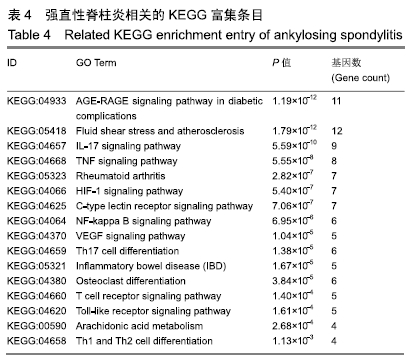
| [1] 刘彧.强直性脊柱炎免疫遗传学发病机制的研究进展[J].中国临床医学, 2019,26(1):117-121. [2] 张莉,沈海丽.老年强直性脊柱炎患者临床治疗及生活质量现况分析[J].中国地方病防治杂志,2018,33(2):177-178. [3] 顾春芳,仇雅云,汤悦煦.强直性脊柱炎患者生活质量影响因素分析[J].中国医学前沿杂志(电子版),2017,9(10):145-148. [4] LORIES RJ, HAROON N, Evolving concepts of new bone formation in axial spondyloarthritis: Insights from animal models and human studies. Best Pract Res Clin Rheumatol.2017;31(6): 877-886. [5] 王田玲,徐亮.强直性脊柱炎骨桥形成与炎症关系的研究进展[J].中国临床药理学与治疗学,2015,20(1):101-105. [6] LI X,WANG J,ZHAN Z,et al. Inflammation Intensity-Dependent Expression of Osteoinductive Wnt Proteins Is Critical for Ectopic New Bone Formation in Ankylosing Spondylitis.Arthritis Rheumatol. 2018 70(7):1056-1070. [7] 杜天信,韩新峰,高书图.寒湿痹颗粒治疗寒湿痹阻型风湿病的效果分析[J].中国临床康复,2006,10(7):148-150. [8] 王承德,姜泉,冯兴华,等.寒湿痹颗粒治疗风湿病寒湿痹阻证临床研究[J].中国中医急症,2008,17(2):175-177. [9] 庞红梅.寒湿痹颗粒治疗类风湿关节炎、强直性脊柱炎和膝骨关节炎中医辨证属寒湿痹阻证的临床疗效[J].中医临床研究,2014,6(26):87-88. [10] 杜天信,韩新峰,高书图.寒湿痹颗粒治疗寒湿痹阻型风湿病的临床观察——附375例报告[J].中医正骨,2002,14(3):10-12. [11] 陈佩虹,甘丽,辛增辉,等.寒湿痹片抑制大鼠滑膜增生及相关机制研究[J].中国实验方剂学杂志,2009,15(11):73-75. [12] 陈育尧,佟丽,吴启富,等.寒湿痹片对类风湿性关节炎模型大鼠踝关节组织病理改变的影响[J].浙江中西医结合杂志,2010,20(1):12-14. [13] 朱梓铭,张因彪,郑景辉,等.基于网络药理学探究苓桂术甘汤治疗慢性心力衰竭的作用机制[J].临床心血管病杂志, 2019,35(2):154-161. [14] HAREL A, INGER A, STELZER G, et al.GIFtS: annotation landscape analysis with GeneCards. Bmc Bioinformatics.2009;10(1):348-348. [15] 叶清,李俊年,杨冬梅,等.植物槲皮素对东方田鼠免疫功能的影响[J].兽类学报,2019,39(1):77-83. [16] 尧荣凤,李智,许国祥,等.中药活性成分抗自身免疫性关节炎作用的研究[J].中国骨与关节损伤杂志,2015,30(8):859-862. [17] YUAN Z, MIN J, ZHAO Y, et al. Quercetin rescued TNF-alpha-induced impairments in bone marrow derived mesenchymal stem cell osteogenesis and improved osteoporosis in rats.Am J Transl Res. 2018;10(12):4313-4321. [18] 贾庆运,王拥军,梁倩倩,等.槲皮素对小鼠胶原诱导性关节炎症的影响[J].中国骨质疏松杂志,2018,24(9):1175-1179. [19] 马纳,李亚静,范吉平.槲皮素药理作用研究进展[J].辽宁中医药大学学报, 2018,20(8):221-224. [20] 范轶鑫,刘海姣,李艺璇,等.槲皮素抑制脊髓小胶质细胞基质金属蛋白酶的表达改善术后疼痛的机制研究[J].中国药科大学学报, 2017,48(3): 343-347. [21] 晁杲,廖圣宝,周静,等.异鼠李素抗骨质疏松作用及机制探讨[J].中国医院药学杂志,2016,36(17):1456-1460. [22] 刘威良,姬昱,黄艾祥.β-谷甾醇的研究及开发进展[J].农产品加工,2019(1): 77-82. [23] 肖志彬,贾韩学,刘小雷.β-谷甾醇药理活性的研究现状[J].世界最新医学信息文摘,2015,15(8):66-68. [24] 张玲玲,魏伟.治疗自身免疫病药物研究进展[J].中国药理学通报,2019, 35(2):149-156. [25] 李艳,孙文星,徐春瑛,等.NCOA2核心启动子甲基化分析及其与肾周和皮下脂肪组织差异表达的关系[J].南京农业大学学报, 2014,37(4):131-136. [26] 倪海键,史冬泉,蒋青.CALM1基因及钙调素与骨关节炎[J].国际骨科学杂志,2008,(1):43-45. [27] 乔丹丹,罗林.热休克蛋白90与肿瘤的生物学特性[J].云南医药,2016, 37(6):676-679. [28] 周熹. CALM1/CALM2基因多态性与青少年特发性脊柱侧凸遗传易感性的关联性研究[D]. 北京:北京协和医学院,2009. [29] 曹青青,傅照华.TNF-α与IL-1β对膝骨性关节炎的影响及展望[J].世界最新医学信息文摘,2017,17(58):37-38. [30] RABELO CF, BAPTISTA TSA, PETERSEN LE, et al. Serum IL-6 correlates with axial mobility index (Bath Ankylosing Spondylitis Metrology Index) in Brazilian patients with ankylosing spondylitis.Open Access Rheumatol.2018;10: 21-25. [31] 艾香艳,赵福涛,王艳玲.血清肿瘤坏死因子-α在老年痛风性关节炎中的变化特点及意义[J].老年医学与保健,2019,25(1):21-42. [32] HARRIS RE, CASTO BC, HARRIS ZM.Cyclooxygenase-2 and the inflammogenesis of breast cancer.World J Clin Oncol. 2014;5(4): 677-692. [33] LALIER L, PEDELABORDE F, BRAUD C, et al.Increase in intracellular PGE2 induces apoptosis in Bax-expressing colon cancer cell.BMC Cancer.2011;11(1):153. [34] YANG S, GAO Q, JIANG W.Relationship between tumour angiogenesis and expression of cyclo-oxygenase-2 and vascular endothelial growth factor-A in human renal cell carcinoma.J Int Med Res. 2015;43(1):110-117. [35] 刘莹,朱超,刘娟芳.活性氧与慢性神经病理性疼痛研究进展[J].中华神经外科疾病研究杂志,2014,13(4):382-384. [36] 代喆,季振中,徐焱成.长链脂肪酸通过GPR120对脂肪细胞炎症、内质网应激及胰岛素信号分子的影响[J].中日友好医院学报,2014,28(4): 222-233. [37] 宋俊垚.从JAK/STAT信号通路调控Th17分化探索补肾、清热、活血法干预强直性脊柱炎炎症分子机制[D].北京:北京中医药大学,2016 [38] 曹溆,张克勤.损伤相关分子模式与器官移植[J].中国免疫学杂志,2017, 33(11):1755-1760. [39] 杨秀颖,张莉,陈熙,等.2型糖尿病周围神经病变机制研究进展[J].中国药理学通报,2016,32(5):598-602. [40] BIERHAUS A, HUMPERT PM, MORCOS M, et al. Understanding RAGE, the receptor for advanced glycation end products.J Mol Med (Berl). 2005;83(11):876-886. [41] 曹永平,吴浩.骨细胞与应力信号传导[J].中华骨质疏松和骨矿盐疾病杂志, 2012,5(4):237-246. [42] 杨屹羚,张鹏,江凌勇.流体剪应力在骨髓基质干细胞成骨向分化中作用机制的研究进展[J].医用生物力学,2018,33(4):378-382. [43] 秦臻,张彦燕,韦正新,等.当归补血汤在流体剪切应力环境中对内皮细胞功能的影响[J].北京中医药大学学报, 2018,41(8):630-635. |
| [1] | Yuan Jiawei, Zhang Haitao, Jie Ke, Cao Houran, Zeng Yirong. Underlying targets and mechanism of Taohong Siwu Decoction in prosthetic joint infection on network pharmacology [J]. Chinese Journal of Tissue Engineering Research, 2021, 25(9): 1428-1433. |
| [2] | Geng Qiudong, Ge Haiya, Wang Heming, Li Nan. Role and mechanism of Guilu Erxianjiao in treatment of osteoarthritis based on network pharmacology [J]. Chinese Journal of Tissue Engineering Research, 2021, 25(8): 1229-1236. |
| [3] | Li Zhongfeng, Chen Minghai, Fan Yinuo, Wei Qiushi, He Wei, Chen Zhenqiu. Mechanism of Yougui Yin for steroid-induced femoral head necrosis based on network pharmacology [J]. Chinese Journal of Tissue Engineering Research, 2021, 25(8): 1256-1263. |
| [4] | Li Shibin, Lai Yu, Zhou Yi, Liao Jianzhao, Zhang Xiaoyun, Zhang Xuan. Pathogenesis of hormonal osteonecrosis of the femoral head and the target effect of related signaling pathways [J]. Chinese Journal of Tissue Engineering Research, 2021, 25(6): 935-941. |
| [5] | Cao Xuhan, Bai Zixing, Sun Chengyi, Yang Yanjun, Sun Weidong. Mechanism of “Ruxiang-Moyao” herbal pair in the treatment of knee osteoarthritis based on network pharmacology [J]. Chinese Journal of Tissue Engineering Research, 2021, 25(5): 746-753. |
| [6] | Li Yonghua, Feng Qiang, Tan Renting, Huang Shifu, Qiu Jinlong, Yin Heng. Molecular mechanism of Eucommia ulmoides active ingredients treating synovitis of knee osteoarthritis: an analysis based on network pharmacology [J]. Chinese Journal of Tissue Engineering Research, 2021, 25(5): 765-771. |
| [7] | Xiao Fangjun, Chen Shudong, Luan Jiyao, Hou Yu, He Kun, Lin Dingkun. An insight into the mechanism of Salvia miltiorrhiza intervention on osteoporosis based on network pharmacology [J]. Chinese Journal of Tissue Engineering Research, 2021, 25(5): 772-778. |
| [8] | Wang Qiufei, Gu Ye, Peng Yuqin, Xue Feng, Ju Rong, Zhu Feng, Wang Yijun, Geng Dechun, Xu Yaozeng. Effect of Wnt/beta-catenin signaling pathway on osteoblasts under the action of wear particles [J]. Chinese Journal of Tissue Engineering Research, 2021, 25(24): 3894-3901. |
| [9] | Fan Junchao, Chen Yong, Song Junjie. Sevoflurance combined with xenon pretreatment protects against spinal cord ischemia-reperfusion injury in a rat model [J]. Chinese Journal of Tissue Engineering Research, 2021, 25(23): 3660-3665. |
| [10] | Liu Jinfu, Zeng Ping, Nong Jiao, Fan Siqi, Feng Chengqin, Huang Jiaxing. Integrative analysis of biomarkers and therapeutic targets in synovium of patients with osteoarthritis by multiple microarrays [J]. Chinese Journal of Tissue Engineering Research, 2021, 25(23): 3690-3696. |
| [11] | Chen Feng, Zhang Xiaoyun, Chen Yueping, Liao Jianzhao, Li Jiajun, Song Shilei, Lai Yu. Molecular mechanism of anhydroicaritin in the treatment of osteoarthritis: an analysis based on network pharmacology and bioinformatics [J]. Chinese Journal of Tissue Engineering Research, 2021, 25(23): 3704-3710. |
| [12] | Zhang Haitao, Chen Jinlun, Zhu Xingyang, Zeng Huiliang, Li Jie, Sun Xiaobo, Qi Xinyu, Zeng Jianchun, Zeng Yirong. Effect and molecular mechanism of Honeysuckle-Rhizoma coptidis in the treatment of periprosthetic joint infection based on molecular docking and network pharmacology [J]. Chinese Journal of Tissue Engineering Research, 2021, 25(21): 3360-3367. |
| [13] | Song Shilei, Chen Yueping, Zhang Xiaoyun, Li Shibin, Lai Yu, Zhou Yi. Potential molecular mechanism of Wuling powder in treating osteoarthritis based on network pharmacology and molecular docking [J]. Chinese Journal of Tissue Engineering Research, 2021, 25(20): 3185-3193. |
| [14] | Zhong Yuanming, He Bingkun, Wu Zhuotan, Wu Sixian, Wan Tong, Zhong Xifeng. An exploration on the mechanism of Shaoyao Gancao Decoction in treating early pain of lumbar disc herniation based on network pharmacology [J]. Chinese Journal of Tissue Engineering Research, 2021, 25(20): 3194-3201. |
| [15] | Chen Xinling, Wang Shenglan. Cell autophagy, pathway, regulation and its multiple correlations with pulmonary hypertension [J]. Chinese Journal of Tissue Engineering Research, 2021, 25(2): 311-316. |
| Viewed | ||||||
|
Full text |
|
|||||
|
Abstract |
|
|||||

